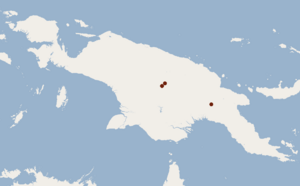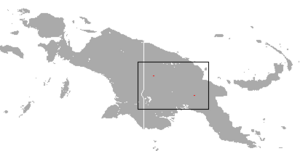Bulmer's fruit bat facts for kids
Quick facts for kids Bulmer's fruit bat |
|
|---|---|
 |
|
| The Distribution of Aproteles bulmerae | |
| Conservation status | |
| Scientific classification | |
| Genus: |
Aproteles
|
| Species: |
bulmerae
|
 |
|
| Bulmer's Fruit Bat range | |
The Bulmer's fruit bat (Aproteles bulmerae) is a type of megabat that lives only in New Guinea. It is known as a fruit bat because it eats fruit. This bat is in great danger of disappearing. This is mainly because its home is being destroyed and people hunt it.
It is the only member of its group, called Aproteles. Because it is so rare, a group called the Alliance for Zero Extinction has listed it. They say it is a species that could become extinct very soon.
What's in a Name?
The name of the bat's group, Aproteles, comes from Greek words. It means "incomplete at the front." This name refers to the fact that these bats are missing some of their lower front teeth.
The species name, bulmerae, was given to honor Susan Bulmer. She was an archaeologist who found the first old bones of this bat. She dug them up from the ground where they had been for a very long time.
Where They Live and What They Need
Bulmer's fruit bats live in caves. They are found in forests high up in the mountains. They have been seen living in a cave about 2,300 meters (7,500 feet) above sea level. These bats usually live between 1,800 and 2,400 meters (about 5,900 to 7,900 feet) high. They are found in a special mountain area called the Maoke Range Alpine Heathlands.
The first Bulmer's fruit bats were known from 12,000-year-old fossils. These very old bones were found in the central highlands of Chimbu Province, in Papua New Guinea. It is thought that they might have died out there about 9,000 years ago.
In 1975, living Bulmer's fruit bats were found again. They were discovered in the Hindenburg Wall area of Western Province, Papua New Guinea. They were in a cave known as Luplupwintem. At that time, local people said there were many bats, perhaps thousands.
However, just two years later, the bat colony was almost wiped out. This happened because hunters entered the cave with shotguns and ropes. During the 1980s, no bats were seen at all. People worried that the species might have become extinct. But by 1993, a group of about 160 bats was found living in the same cave.
Bulmer's fruit bats also lived in the Telefomin region of Sandaun Province, Papua New Guinea, as recently as 1984. Other groups of these bats have been reported from near Herowana in Eastern Highlands Province. They have also been seen near Crater Mountain in Chimbu Province, both in Papua New Guinea.
How They Live
Bulmer's fruit bats live together in colonies inside caves. They are not ready to have babies until they are almost three years old. Baby bats are usually born in April. For the first few weeks, a baby Bulmer's fruit bat is carried by its mother. She carries it while she flies around looking for food.
Based on their teeth and how they are related to other fruit-eating bats, Bulmer's fruit bats mostly eat fruit. Their diet includes figs.
Protecting Them
Hunting and people disturbing their homes are the main reasons why these bats have become so rare. The bat colony at Luplupwintem Cave was traditionally protected by the local people. But in the mid-1970s, new equipment and guns became available. This led to the bat colony being almost destroyed.
In 2013, Bat Conservation International put this bat on its list of 35 top priority species. These are species that need urgent help around the world. The Bulmer's fruit bat is currently listed as Critically Endangered by the IUCN. This means it faces a very high risk of disappearing forever.


